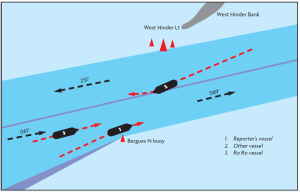The Charity
Aviation
Maritime
Fishing Vessels and Traffic Separation Schemes

Initial Report
Outline:
A report of fishing vessels contravening Rule 10 in the vicinity of the Foxtrot 3 buoy in the Dover Straits.
What the Reporter told us
At least five fishing vessels were noted to be contravening Rule 10 in the English Channel. The vessels were in radar range of Dover Coast Guard / CROSS Gris Nez Traffic, but none of the fishing vessels were called by either station. I have observed this numerous times, and have seen many vessels get into difficult situations with fishing boats behaving in this way. At no point were any fishing vessels spoken to by either observing station during the course of my four hour watch.
The reporter additionally stated the belief that more awareness from Coast Stations and a stronger stance on COLREGS in places such as the English Channel is required, to ensure that there are no collisions caused by the behaviour of these fishing vessels.

ECDIS Display of fishermen contravening Rule 10 in the vicinity of F3 buoy.
Further dialogue with the reporter determined that tidal streams were against own ship for the transit and that the fishermen were showing a speed over the ground of 4.6 knots. CHIRP agreed to discuss the matter further with Dover Channel Navigation Information Service, and national fisheries organisations.
What the Third Party told us
Dover Coastguard responded as follows
“We at Dover Coastguard endeavour to ensure full compliance with the collision regulations by all vessels using the Traffic Separation Scheme, and a report and follow up action is always completed on any vessel found to be contravening the regulations, or going against recommended routing.
I will be looking back at the recordings for this incident to get a better understanding of it and any follow up action that came from it. If there is any requirement for awareness I will ensure this is promulgated to our teams. However, it may useful to mention that a vessel in this situation may report a breach of Collision Regulations to the Coastguard and can also do the same within French territorial waters to CROSS Gris Nez, this would then form a hazardous incident report which has a specific investigation procedure associated with it and can be useful to us to ensure effectiveness of the traffic lanes and maritime safety”.
The National Federation of Fishermen’s Organisations advised that the lack of enforcement in the TSS on the French side and even for foreign fishing vessels in the UK side is well known. It is typical for Dover to contact vessels to give them a warning and the UK fishing vessels tend to react immediately but vessels of other nationalities tend to disregard the warnings. This is an observation rather than a criticism, but without an even-handed approach towards all vessels it is only encouraging the good vessels to do bad. It is also highlighted that sometimes tidal streams can affect the speed or drift of fishing vessels and they may not realise they are already within the TSS. They should monitor their position regularly.
CHIRP Comment
Having discussed the report, the Maritime Advisory Board commented that there is obviously an issue to be resolved, and took the unusual step of agreeing that the location of the report be identified in order for the safety lessons to be promulgated accurately.
Another factor for readers to be aware of is the widespread use of rotating amber lights by fishermen in addition to the lights required by COLREGS. This is often confusing and leads to vessels giving way when they may not be required to do so – hence their popularity with fishing vessels.
Should you find yourself in a position where fishermen are contravening Rule 10 in the Dover Straits, then CHIRP advice is to report this to Dover Coast Guard / CROSS Gris Nez as appropriate in order for them to create a hazardous incident report and launch an investigation.
Report Ends







